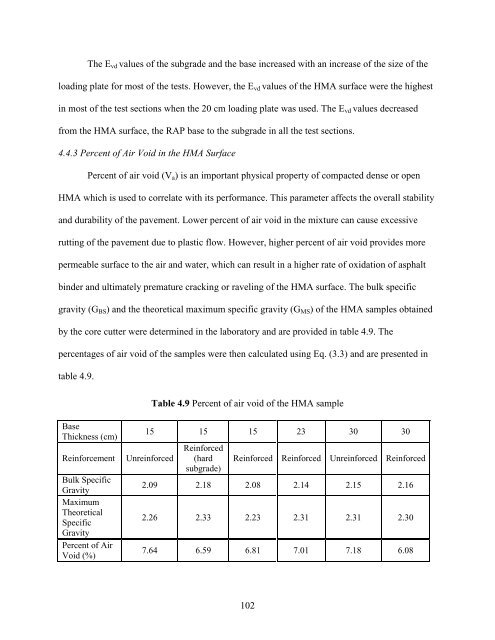Onsite Use of Recycled Asphalt Pavement Materials and Geocells to ...
Onsite Use of Recycled Asphalt Pavement Materials and Geocells to ...
Onsite Use of Recycled Asphalt Pavement Materials and Geocells to ...
You also want an ePaper? Increase the reach of your titles
YUMPU automatically turns print PDFs into web optimized ePapers that Google loves.
The Evd values <strong>of</strong> the subgrade <strong>and</strong> the base increased with an increase <strong>of</strong> the size <strong>of</strong> the<br />
loading plate for most <strong>of</strong> the tests. However, the Evd values <strong>of</strong> the HMA surface were the highest<br />
in most <strong>of</strong> the test sections when the 20 cm loading plate was used. The Evd values decreased<br />
from the HMA surface, the RAP base <strong>to</strong> the subgrade in all the test sections.<br />
4.4.3 Percent <strong>of</strong> Air Void in the HMA Surface<br />
Percent <strong>of</strong> air void (Va) is an important physical property <strong>of</strong> compacted dense or open<br />
HMA which is used <strong>to</strong> correlate with its performance. This parameter affects the overall stability<br />
<strong>and</strong> durability <strong>of</strong> the pavement. Lower percent <strong>of</strong> air void in the mixture can cause excessive<br />
rutting <strong>of</strong> the pavement due <strong>to</strong> plastic flow. However, higher percent <strong>of</strong> air void provides more<br />
permeable surface <strong>to</strong> the air <strong>and</strong> water, which can result in a higher rate <strong>of</strong> oxidation <strong>of</strong> asphalt<br />
binder <strong>and</strong> ultimately premature cracking or raveling <strong>of</strong> the HMA surface. The bulk specific<br />
gravity (GBS) <strong>and</strong> the theoretical maximum specific gravity (GMS) <strong>of</strong> the HMA samples obtained<br />
by the core cutter were determined in the labora<strong>to</strong>ry <strong>and</strong> are provided in table 4.9. The<br />
percentages <strong>of</strong> air void <strong>of</strong> the samples were then calculated using Eq. (3.3) <strong>and</strong> are presented in<br />
table 4.9.<br />
Base<br />
Thickness (cm)<br />
Reinforcement Unreinforced<br />
Bulk Specific<br />
Gravity<br />
Maximum<br />
Theoretical<br />
Specific<br />
Gravity<br />
Percent <strong>of</strong> Air<br />
Void (%)<br />
Table 4.9 Percent <strong>of</strong> air void <strong>of</strong> the HMA sample<br />
15 15 15 23 30 30<br />
Reinforced<br />
(hard<br />
subgrade)<br />
Reinforced Reinforced Unreinforced Reinforced<br />
2.09 2.18 2.08 2.14 2.15 2.16<br />
2.26 2.33 2.23 2.31 2.31 2.30<br />
7.64 6.59 6.81 7.01 7.18 6.08<br />
102
















